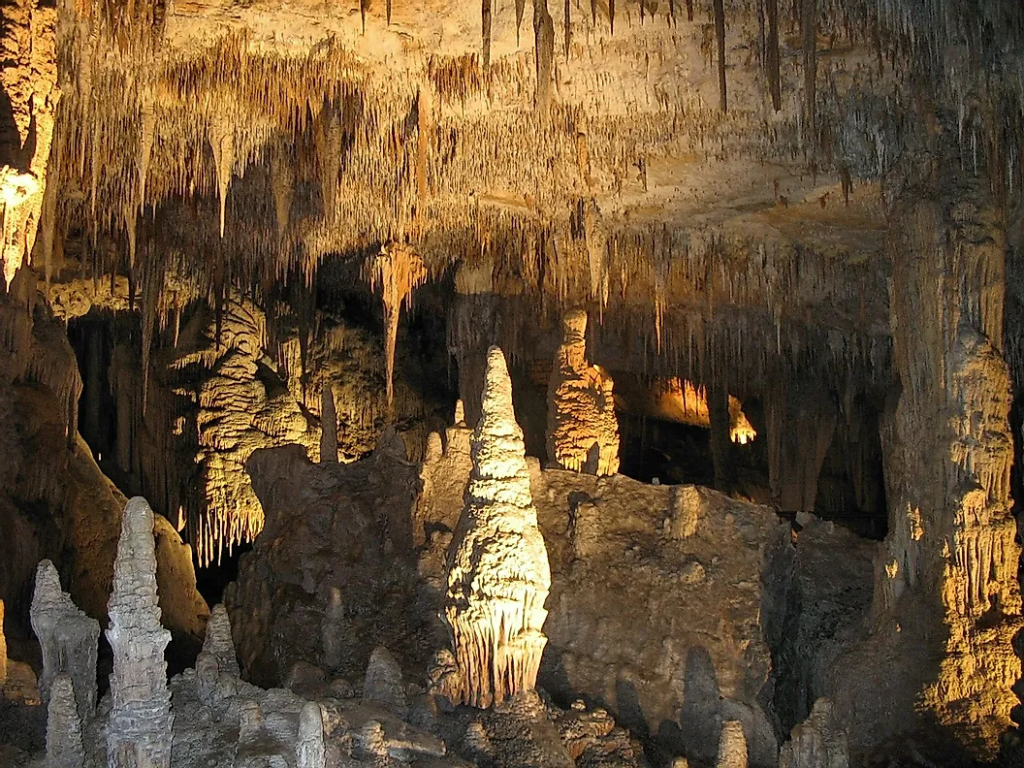Beware: You should never explore wild caves alone or without proper gear. Consider getting in touch with a Grotto of the National Speleological Society at www.caves.org or a qualified cave club. These groups are skilled and will train you. Without sufficient knowledge, preparation, and equipment, cave exploring can lead to serious injury or death.
Stalagmites and Stalactites. Chances are, you’ve gotten the two confused. But don’t worry, by the end of this article, you will know everything you need to know about both.
The main difference is that a stalactite, hangs from the ceiling, while the stalagmite grows from the ground. Both are surreal when seen in person, especially when you understand the history behind them.
This article will discuss the formation of stalactites over millions of years, the locations of these cave features, and the reasons why they are so fascinating to people.
What Are Stalactites?
Stalactites are long, tapered rock formations that dangle from cave ceilings, that form through the accumulation of minerals transported by dripping water. Think about icicles made of minerals like calcite, instead of water.
Each drop leaves little traces of calcite, and these deposits build up to form descending spikes over thousands of years.
You can see an image of a room of stalactites below. These specific formations are called soda straws.

Mineral-rich water emerges from cracks and hangs in drips from the ceiling. A tiny amount of calcite is left behind after each drop. These deposits accumulate over a long period to become stalactites.
The water droplets themselves give the shape that it does. The drip points give rise to the narrow ends, and as the drop size increases below, the lots spread.
The range of growth rates is 0.5 to 2 cm every 100 years. Some stalactites are more than 20 feet long, which would mean an age of 30,000 to 120,000 years!
What are Stalagmites?
Stalagmites are mounds or tapering columns that rise from the floor of a cave, made of calcium salts deposited by dripping water. Over thousands of years, these mounds with rounded or flattened tips gather and build magnificent structures.
Stalagmites have thicker proportions and form from the same drip-water source as stalactites, but don’t always have a stalactite to pair with them.
To find the largest stalagmites, you’ll usually see them in caves of limestone and dolomite.

There’s Actually One More Type…
Imagine a cave that’s left alone long enough. A stalactite would eventually reach the ground, wouldn’t it? In the same vein, a stalagmite could theoretically grow forever. What if the two eventually touch and form a single column? Well, there’s a name for that, too.
A Stalagnate results when stalactites and stalagmites meet or when stalactites reach the floor of the cave. To remember this word, think of the word “stalemate”, which occurs when two opposing forces are unable to move further. This is what happens when the stalactite and stalagmite meet, no longer able to move further in either direction.
A Trick to Remember the Difference between Stalagmite and Stalactite
The words are similar, so it’s easy to get confused at first. However, just remember that stalactite has a “T” for top, while stalagmite has “G”, for ground. This will help you always know which one grows from the top and which grows from the ground.
Where They Can Be Found
High-calcium limestone caverns are home to the most beautiful stalactites. The Doolin Cave in Ireland, the Jeita Grotto in Lebanon, and the Carlsbad Caverns in the United States are well-known places. The climate and temperature of the caves also affect how they form.
For stalactites to fully form, they ideally need a steady, moderate supply of mineralized water. Their fragile architecture might be ruined by excessive dampness or leaks.
Speleothems that are thicker and shorter typically grow in more humid cave conditions. The most striking ones hang in places where droplets have slowly fallen for millennia.

Conclusion
The longevity of stalactites, stalagmites, and other speleothems depends on preservation efforts. Stalactite protection requires careful cave management, limiting human intrusion, and increasing public awareness of the vulnerability of cave formations.
To learn about more cave formations, check this article next.
Let us ensure that these geological marvels, suspended in time and ready to communicate their silent stories with those who travel into the underground realm, endure for years to come as we continue to be amazed by the hanging wonders of stalactites.
